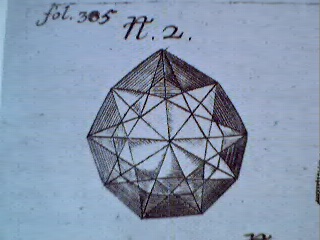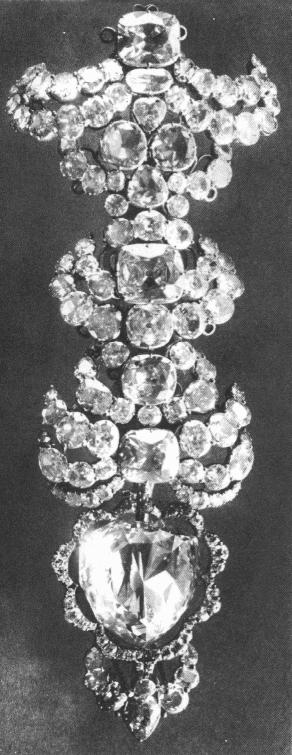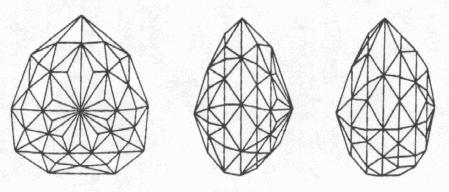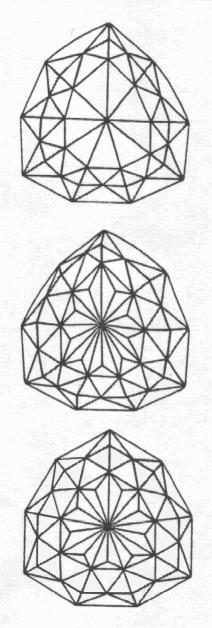Florentine Diamond
History/Detail of the Florentine Diamond

This cubic zirconium replica was designed and cut by Scott Sucher. Sucher said he had to use mathematics to figure out the angles and measurements of the sides of the stone

Jean Baptiste Tavernier's book first published 1676 in French, and translated
into English by Valentine Ball in 1925. The book shows the Florentine
as being a 9-sided double rose cut stone with a shield shape.
Once the great yellow diamond of the Medici Family, this historic Indian stone is actually light yellow in color with a very slight green overtone and is fashioned in the form of an irregular, nine-sided, one 126-facet double rose cut. It weighed 137.27 carats.
Legends surrounding the stone date as far back as 1467, when Charles the Bold, Duke of Burgundy, is said to have been wearing it when he fell in battle. A peasant or foot soldier found it on the Duke's person and sold it for a florin, thinking it was glass, after which it changed hands innumerable times for small sums of money. Pope Julius II is named as one of the owners.
Authentic history begins when Tavernier, the famous French jeweler and traveler, saw the stone amoung the treasures of the Grand Duke of Tuscany in 1657. When the last of the Medici's died, it passed to Vienna through the marriage of Francis Stephan of Lorraine (who later became the Grand Duke of Tuscany) to Empress Maria Theresa and was placed in the Hapsburg Crown Jewels in the Hofburg, Vienna; at the time, it was valued at $750,000.

Florentine's last known setting - a hat ornament.
This photo was probably taken between 1870 and 1880.
After the fall of the Austrian Empire, during World War I, the Florentine was taken by the Imperial Family into exile in Switzerland. Later, it was thought to have been stolen by a person close to the Family and taken to South America with other gems of the Crown Jewels. After this, it was rumored that the great diamond was brought into the United States in the 1920's and was recut and sold. As a matter of record, it must be listed with other "lost" renowned diamonds of the world. Officials at the Kunsthistorisches Museum in Vienna, where the Florentine was on display prior to 1918 in a hat ornament, state to the Gemological Insitute of America in 1964 that they no knowledge of the stone's present location.
The Tuscan, the Grand Duke of Tuscany, the Austrian Diamond, and the Austrian Yellow Brilliant.

A drawing of the Florentine from Max Bauer's 1904 book Precious Stones. The left and right are Bauer's front and side views of the stone, the center is the side view corrected to match Bauer's front view - note the extra facets. This style of briolette is called a double-rose, due to the fact the stone has a girdle. Briolettes, like the Briolette of India, are round when viewed from the end and usually have a very small hole drilled at their point, allowing them to be worn as a sort of large pendant-bead. To me, this design seems like it is one of the most accurate, with the actual diamond being slightly less oblong (less like a pear shape and more like a shield), as visible in the b&w photograph. You'll also note there more facets towards the center of the stone, whereas Tavernier's drawing leaves them out. The b&w photo shows a thin triangular facet, at a 4 O'Clock angle from the center of the stone. It appears grayish with the facets around it being illuminated. I believe this is one of the extra facets Tavernier's drawing left out, of which there are nine. At the 1:30 angle from the center, the extra facet is again visible but as a light gray with the facets around it dimmed.

In Herbert Tillander's book Diamond Cuts in Historic Jewelry - 1381 to 1910, there are a number of drawings of the Florentine from over the past few centuries. The Tavernier drawing is shown, the Bauer drawing as well as the 189-facet Cletscher drawing, and several others. Directly above is Tillander's drawing for the correct outline and faceting of the stone, which I agree with. It has 144 facets total -- 81 on the crown and 63 on the pavilion. The top drawing is the back of the diamond, the middle is the front, and the lower is a symmetrized version. The high center of the front of the gem is trihedrally faceted, whereas the same area on the reverse has only nine basic facets. As it turns out, Tavernier's drawing was the reverse of the stone! The stone is somewhat 'slanted'. This seems reasonable, considering the gem was cut around 1615. It is unlikely it would have been as symmetrical as diamonds cut later, like the Regent or the Tiffany Yellow.

Image from Jean Baptiste Tavernier's book "The Six Voyages of
Jean Baptiste Tavernier"
Once the great yellow diamond of the Medici Family, this historic Indian stone is actually light yellow in color with a very slight green overtone and is fashioned in the form of an irregular, nine-sided, one 126-facet double rose cut. It weighed 137.27 carats.
Legends surrounding the stone date as far back as 1467, when Charles the Bold, Duke of Burgundy, is said to have been wearing it when he fell in battle. A peasant or foot soldier found it on the Duke's person and sold it for a florin, thinking it was glass, after which it changed hands innumerable times for small sums of money. Pope Julius II is named as one of the owners.
The Florentine Diamond (faceted in 1615) has several names. It has been called the Tuscan, the Tuscany Diamond, the Grand Duke of Tuscany, and even the Austrian Yellow Diamond - an unfortunate name, since it creates confusion with another lost diamond, the Austrian Yellow Brilliant.
The stone was drop-shaped with both the front and reverse more or less similarly faceted. The center of the front had trihedral faceting, but the matching area on the reverse simply had nine basic facets. Both front and reverse were stepped twice, producing nine rows, each containing nine facets in the front, and nine rows of seven facets on the reverse - 144 facets in all. The overall impression is a nine-rayed star.
Through the works of Speranza Cavenago Bignami, Guido Gregorietti and others, Herbert Tillander was able to trace the history of this stone. P. Aloisi stated in 1932 that the rough stone was 'acquired' in the late 1500s from the King of Vijayanagar (now Narsingha) in southern India by the Portuguese Governor of Goa, Ludovico Castro, Count of Montesanto, after the king's defeat by Portugese troops. The crystal was deposited with the Jesuits in Rome until, after lengthy negotiations, Grand Duke Ferdinand I of Tuscany succeeded in buying it from the Castro-Noranha family for 35,000 Portuguese scudi crocati.
Duke Ferdiand's son, Grand Duke Cosimo II (who ruled from 1609 to 1621), finally entrusted his father's purchase to a cutter, Pompeo Studentoli, a Venetian working in Florence. The finished gem was delivered on October 10th, 1615. An inventory drawn up on Cosimo's death confirms the acquisition of the rough diamond by Ferdinand and describes the gem as 'faceted on both sides and encircled by a diamond encrusted band'.
Dr. Heinz Biehn reproduced a sketch of a pendant containing the Florentine with a caption reading, "Il Gran Diamante del Serimo Gran Duca di Toschana, Pesa 138 Carati". Despite extensive investigation, the origin of this drawing remains obscure. The correct weight and the exact faceting indicate that it was probably drawn just after its fashioning in 1615. The outline differs slightly, most likely because the artist wished to show a perfect and therefore pleasing symmetry.
Thomas Cletscher, who must have seen the great gem in Florence, produced a clearly recognizable sketch of it in about 1625: neither the faceting nor the outline is absolutely correct, which indicates that it may have been done from memory. The faceting of the central trihedrally faceted section is fairly accurate, but the surrounding steps, which he depicts as being similarly fashioned, cannot be correct. Cletscher also gives the weights of the rough and the finished gem as being 170 carats and 120 carats, neither of which appear to be accurate.
A company called Gem Slueth set out to find out what happened to the diamond, and their initial theory was that it had been recut. But because of the Florentine’s unusual shape, anything other than a round cut would create a truly drastic loss of valuable diamond weight. Gem Slueth researched and found that there are only four light-yellow diamonds that weigh over 70 carats. Quickly three of these diamonds were eliminated as possibilities, due to one fact or another that places them somewhere else during the existence of the Florentine as a 137.27-carat stone. Only one, an 80-carat light yellow diamond that was auctioned in Switzerland in 1981, might possibly be the missing Florentine. Further research followed, including conversations with the woman who had sold the diamond in 1981. It had been, she reported, in her family since shortly after World War I (the Florentine was stolen in 1918). She remembered it being a very unusual shape prior to her father having the jewel recut. Lord Ian Balfour, Britain’s noted diamond historian and De Beers have supported Gem Sleuth’s theory on what became of the Florentine diamond. The theory has also appeared in numerous publications. The present whereabouts of the 80-carat